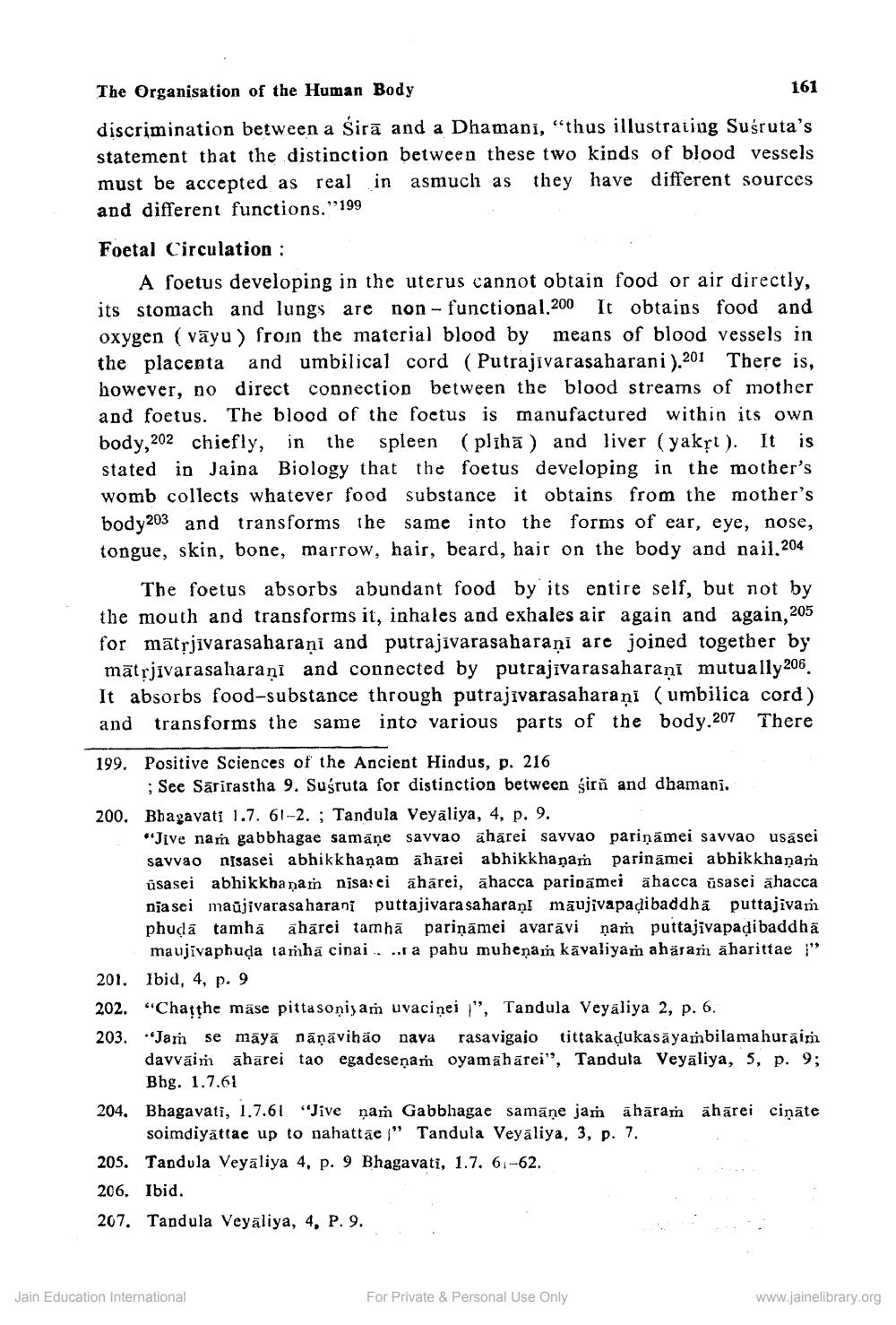________________
The Organisation of the Human Body
discrimination between a Sira and a Dhamani, "thus illustrating Suśruta's statement that the distinction between these two kinds of blood vessels must be accepted as real in asmuch as they have different sources and different functions."*199
Foetal Circulation:
A foetus developing in the uterus cannot obtain food or air directly, its stomach and lungs are non functional.200 It obtains food and oxygen (vayu) from the material blood by means of blood vessels in the placenta and umbilical cord (Putrajivarasaharani),201 There is, however, no direct connection between the blood streams of mother and foetus. The blood of the foetus is manufactured within its own body, 202 chiefly, in the spleen (pliha) and liver (yakṛt). It is stated in Jaina Biology that the foetus developing in the mother's womb collects whatever food substance it obtains from the mother's body203 and transforms the same into the forms of ear, eye, nose, tongue, skin, bone, marrow, hair, beard, hair on the body and nail.204
161
The foetus absorbs abundant food by its entire self, but not by the mouth and transforms it, inhales and exhales air again and again,205 for matṛjivarasaharani and putrajīvarasaharaṇī are joined together by mātṛjīvarasaharani and connected by putrajīvarasaharaṇī mutually 206. It absorbs food-substance through putrajīvarasaharani (umbilica cord) and transforms the same into various parts of the body.207 There
199.
Positive Sciences of the Ancient Hindus, p. 216
; See Sarirastha 9. Suśruta for distinction between girñ and dhamani. 200. Bhagavati 1.7. 61-2.; Tandula Veyaliya, 4, p. 9.
"Jive nam gabbhagae samane savvao aharei savvao pariņāmei savvao usasei savvao nisasei abhikkhanam aharei abhikkhaņam parināmei abhikkhanam ūsasei abhikkhanam nisa: ci āhārei, āhacca parināmei ähacca ūsasei āhacca niasei maūjivarasaharani puttajivara saharan! maujivapaḍibaddha puttajivam phuḍā tamha aharei tamha pariņāmei avaravi nam puttajivapaḍibaddha maujivaphuḍa tamha cinai...a pahu muhenam kavaliyam aharam āharittae "
201. Ibid, 4, p. 9
202. "Chatthe mase pittasoniyam uvacinei ", Tandula Veyaliya 2, p. 6.
203. Jam se māyā nāṇāvihão nava rasavigajo tittakaḍukasayambilamahuraim davvaim āhārei tao egadeseṇam oyamaharei", Tandula Veyaliya, 5, p. 9; Bbg. 1.7.61
204. Bhagavati, 1.7.61 "Jive nam Gabbhagae samane jam āhāram āhārei ciņāte soimdiyattae up to nahattae " Tandula Veyaliya, 3, p. 7.
205. Tandula Veyaliya 4, p. 9 Bhagavati, 1.7. 61-62.
206. Ibid.
207. Tandula Veyaliya, 4, P. 9.
Jain Education International
For Private & Personal Use Only
www.jainelibrary.org




